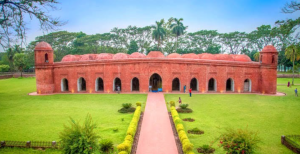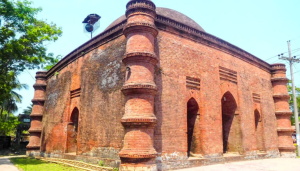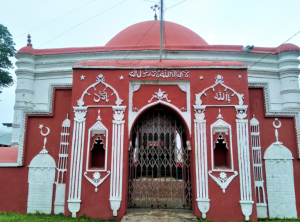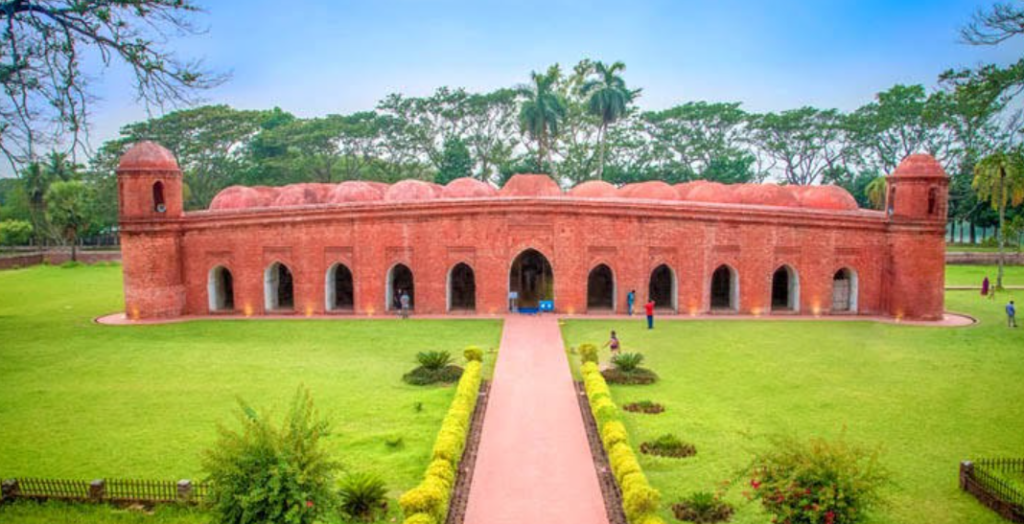Bagerhat, located in the southwestern part of Bangladesh, is a district renowned for its historical, cultural, and ecological significance. Often referred to as the “City of Mosques,” this UNESCO World Heritage Site showcases a remarkable fusion of medieval Islamic architecture and natural beauty. It stands as a living testament to the ingenuity and vision of its founder, Khan Jahan Ali.
In the 15th century, Khan Jahan Ali, a Turkish general and Sufi saint, established Bagerhat, transforming it from a dense mangrove forest into a flourishing Islamic township known as Khalifatabad. His innovative approach to urban planning is evident in the city’s well-organized layout, which includes intricately designed mosques, sophisticated water management systems, and thoughtfully created public spaces. Today, Bagerhat is not only a destination for travelers but also a symbol of Bangladesh’s rich cultural heritage and spiritual legacy.

Sixty Dome Mosque (Shat Gombuj Masjid):
The crown jewel of Bagerhat, this mosque is an architectural masterpiece of the Bengal Sultanate. Built with terracotta and bricks, its sixty domes, supported by seventy-seven intricately carved pillars, create a mesmerizing effect.

Nine Dome Mosque
Located near the Sixty Dome Mosque, this mosque is known for its nine majestic domes and terracotta designs depicting floral and geometric patterns.

Singair Mosque:
An often-overlooked gem, this mosque showcases unique Islamic motifs and is a favorite among history enthusiasts.
Ronvijoypur Mosque:
Home to one of the largest single domes in South Asia, this mosque stands as a marvel of engineering and design.

Khan Jahan Ali’s Mausoleum:
The final resting place of Bagerhat’s founder is a revered site for visitors, featuring an austere yet elegant tomb surrounded by tranquil greenery.
Bagerhat, a region of exquisite natural beauty, offers a harmonious blend of lush greenery, tranquil rivers, and proximity to the awe-inspiring Sundarbans Mangrove Forest, a UNESCO World Heritage Site. The Sundarbans, renowned for its unique ecosystem, is home to the iconic Royal Bengal Tiger, estuarine crocodiles, spotted deer, and an array of vibrant bird species. Its intricate network of tidal waterways and dense mangrove trees make it a haven for adventurers and nature enthusiasts.
The Pashur River, gracefully winding through Bagerhat, provides an excellent opportunity for boat tours. These journeys offer breathtaking views of the serene countryside and occasional glimpses of the Sundarbans’ enchanting wildlife. Another highlight of Bagerhat is the Khan Jahan Ali Dighi, a vast water reservoir constructed by the historical figure Khan Jahan Ali. This site serves as both a historical landmark and a serene retreat for visitors seeking peace and reflection.
For those looking to immerse themselves in the rural charm of Bagerhat, Chitalmari Char is an idyllic destination. Perfect for picnics and bird-watching, this scenic spot captures the essence of Bagerhat’s natural beauty and tranquil ambiance. Whether exploring its rich history or marveling at its natural wonders, Bagerhat is a treasure trove waiting to be discovered.
Cultural and Spiritual Significance
The district is deeply rooted in spirituality and culture, with its mosques and shrines drawing both devotees and tourists.
- Dargha of Khan Jahan Ali:
This spiritual hub is a major pilgrimage site, where people from across the country come to pay their respects to the founder of Bagerhat. - Religious Harmony:
Bagerhat has a legacy of coexistence among various communities, reflected in its cultural festivals and traditions.
Bagerhat’s Upazilas: A Tapestry of Diversity
The district comprises nine upazilas, each offering unique experiences:
- Bagerhat Sadar: The administrative and cultural center, home to the Sixty Dome Mosque and other historical landmarks.
- Rampal: Known for its lush greenery and vibrant rural life.
- Mongla: A bustling port city and the gateway to the Sundarbans.
- Fakirhat: Famous for its traditional crafts and cultural events.
- Morrelganj: Offers scenic beauty and vibrant local markets.
- Kachua: A serene upazila with rich agricultural landscapes.
- Chitalmari: Known for its riverside charm and agricultural significance.
- Sarankhola: A key entry point to the Sundarbans, ideal for eco-tourism.
- Mollarhat: A tranquil region with vibrant cultural festivals.
Famous Personalities of Bagerhat
- Khan Jahan Ali: The founder and visionary behind Bagerhat’s transformation.
Bagerhat’s Culinary Delights
Bagerhat’s cuisine is as rich as its history. Freshwater fish dishes, Sundarbans honey, and traditional Bengali sweets are some of the district’s specialties. Don’t miss trying ilish maach (hilsa fish), a delicacy in this region.
Tourism in Bagerhat
The district has a well-developed tourism infrastructure, with accommodations ranging from eco-friendly resorts near the Sundarbans to budget-friendly hotels in Bagerhat Sadar. Guided tours, boat cruises, and local cultural events enrich the visitor experience.
Why Visit Bagerhat?
Bagerhat is a treasure trove of historical wonders and natural beauty. It invites visitors to explore its rich heritage, immerse themselves in its serene landscapes, and connect with its vibrant cultural tapestry. A visit to Bagerhat promises an unforgettable experience, blending history, spirituality, and the allure of nature in perfect harmony.

